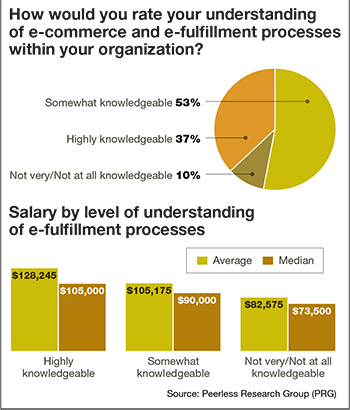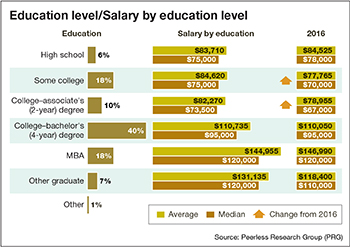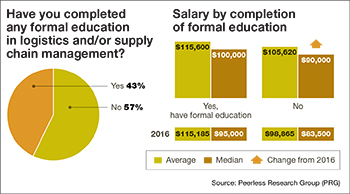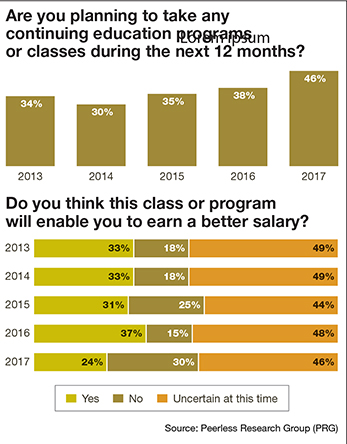Logistics and Supply Chain Education: Opportunities Abound
Here are five trends that every shipper—and potential shipper—must watch as the demand for experienced logistics and supply chain professionals soars.

As global supply chains continue to evolve, and as e-commerce and omni-channel continue to put more and more pressure on our operations, demand for experienced logistics and supply chain managers is increasing exponentially. Here are five emerging trends in logistics and supply chain education and career development that every manager needs to keep an eye on over the coming year.
1.) Supply chain programs proliferate, but fall short on the transportation front.
Gail Rutkowski, executive director for the National Shippers Strategic Transportation Council (NASSTRAC) in Chicago, says that she’s seen a “big uptick” in the recent number of professionals enrolled in master’s supply chain programs.

“When I was young, it was hard to even find any kind of education related to logistics or supply chain,” says Rutkowski. “Today, I think the universities are doing a much better job of offering those kinds of courses to students.”
However, Rutkowski contends that while most of those programs are focused on broader logistics and supply chain management, many fall short when it comes to the all-important transportation segment. “Interestingly enough, Penn State’s supply chain program, which has been around for years, just added transportation to its course offering three years ago,” she points out. “Transportation was something that most of these guys avoided, because you really can’t ‘teach’ transportation in a classroom—you’ve got to get out and do it.”
Even with the current “transportation gap” in education, Rutkowski says universities are doing a good job at creating current, relevant curriculums for today’s budding and veteran supply chain professionals.
“There are some very strong programs out there,” says Rutkowski, who points to Penn State, Brigham Young, University of Tennessee, Georgia Tech and Auburn as a handful of institutions that are leading the pack. “Still, I think they could all be doing a little better on the transportation front.”
2.) The oft-misunderstood Millennial generation needs to “learn by doing.”
Take a look around your organization and you’ll see more Millennials joining the workforce—and they’re looking for opportunities in logistics and supply chain management.
Unlike their predecessors, these “digital natives” have a different outlook on what work should look like as well as how to perform their individual jobs. This reality is hitting hiring and training managers in all industries right now, and logistics is no exception. “Millennials definitely approach work from a different angle,” says Rutkowski, “but that doesn’t mean that they don’t work, or that they don’t work hard.”
Due to its sheer size and prowess, the Millennial generation may just change the way we all think about work—like it or not. “This younger generation is dedicated and it wants to make a difference,” says Rutkowski, “but there are some things that will only come with on-the-job training.”

That becomes an issue when graduates take “gap time” instead of getting right into logistics and supply chain, for example, and miss out on the early on-the-job training that they need to get a foot in the door. “Unfortunately, they’re not going to learn on Snapchat or Instagram,” says Rutkowski. “They’re going to learn by doing.”
At the Institute for Supply Management (ISM), chief content and engagement officer M. L. Peck says that both institutions and companies alike need to focus on learning that combines both theory and hands-on experience when it comes training the next generation of logistics and supply chain decision makers.
ISM, for example, offers an on-demand, subscription-based service that includes hundreds of different learning modules that are broken down into 15 minute—or less—digestible chunks. “They are very narrow and to the point,” says Peck, “which really appeals to younger generations that grew up learning from platforms like YouTube.”
3.) Supply chain managers are seeing compensation bumps, especially for e-commerce.
According to the Logistics Management’s “33rd Annual Salary Survey,” new demands facing logistics managers—mainly driven by the continued double-digit growth of e-commerce—are pushing salaries up to new levels.
The survey also found that professionals are being lured by logistics jobs providing a better standard of living in regions where new concentrations of e-commerce are being created. In the meantime, peak 2017 median salaries remained at $90,000, matching last year’s number, with managers at all levels reporting cost-of-living raises.

However, those survey respondents who have only been in their present position for three years to five years—the highest percentage of those questioned in the survey—captured the greatest gains in income, rising to $97,000 from $87,000 over just the past 12 months.
And finally, survey respondents who said that they’re “highly knowledgeable” about e-commerce are bringing in a median salary of $105,000 compared to the $73,500 earned by those who say they are on the low end of the learning curve.
4.) More women are entering the field, but both genders need to get more interested—and at a younger age.
In a recent “Women in Supply Chain Survey,” Gartner and executive women’s leadership group AWESOME, examined the representation of women in supply chain leadership roles. They also identified practices that are increasing the engagement with and success levels of women in supply chain and logistics.
In particular, the researchers say that the percentage of women in supply chain leadership positions decreases as the corporate ladder rises, and that fewer than half of the companies surveyed have goals of attracting, retaining, and promoting more women into leadership roles.
In fact, just 47% of respondents have the stated goal of increasing the number of female leaders in supply chain (16% have formal goals), while just 42% of those respondents have a “planned, supply-chain led initiative” in place. Abe Eshkenazi, CEO at Chicago-based supply chain management association APICS, sees a sector that’s ripe for change on the human resources front.
“We don’t see a lot of women leaders, and as a result we also don’t see too many women looking at opportunities for leadership; to us that’s a huge issue,” says Eshkenazi. On a positive note, he says that current supply chain grads tend to be split 50/50 on the gender front, and that some companies are even offering “higher pay to women in order to attract them to the organization.”

But there’s still a steep hill to climb when it comes to women in logistics and supply chain management, and particularly on the leadership front. “We’re still not seeing a high volume of individuals going to college to seek out opportunities in supply chain and logistics. Instead, they’re ‘discovering’ the opportunity during their third or fourth year in college,” says Eshkenazi. “That leaves us with a huge opportunity to turn that tide and get both men and women interested in our industry at a younger age.”
One way to do that is through partnerships with STEM (science, technology, engineering, and math) programs at schools, starting at the high school level. “We need to create their awareness of opportunities in supply chain and operations management,” says Eshkenazi, “and develop successful role models that students can look up to and say, ‘You know what? I can do that too.’”
5.) There’s a seat in the C-suite for supply chain and logistics managers, but they’ll need to learn the lingo in order to make an impact.
On the career front, we’re now seeing more logistics and supply chain managers occupying C-suite and boardroom chairs. So, where their jobs were once focused mainly on running transportation operations or overseeing the warehouse and DC, logistics professionals are taking on broader roles at a time when the supply chain itself is growing in importance and relevance.
Some of this may have started as far back as the last recession, says Peck, during a time when logistics and supply chain managers really proved their worth in terms of mapping out more efficient routes to save on fuel, getting the goods to their final destinations quickly, and locking in better supplier pricing. Company leaders sat up and took notice, she adds, and noted the cost savings and efficiencies that came from running a streamlined logistics and supply chain operation.
“As an industry, we really stepped up and started to get a lot of visibility and recognition,” says Peck. That momentum carried right into 2017, a year marked by a stronger economy, but also a persistent need to cut costs and save money.
Financial factors aside, Peck says that logistics and supply chain professionals can also prove their value on the innovation side, where getting products to market faster and more efficiently is an ongoing challenge.

“By including logistics and supply chain in those early, strategic, C-level planning conversations, companies can reduce the time it takes to get to market,” says Peck, who adds that supply chain managers that want a presence in the C-suite can start by getting to know the language and lingo of business and executive management—which, in most cases, revolves around finance.
“As more professionals take this step, everything from job titles to responsibilities to salaries could be elevated exponentially,” adds Peck. “So, instead of talking about inventory turns, talk about working capital and remember that you’re in the C-suite to solve a problem. That’s where you can start to add real value for your organization.”

Article Topics
Magazine Archive News & Resources
Latest in Materials Handling
Beckhoff USA opens new office in Austin, Texas Manhattan Associates selects TeamViewer as partner for warehouse vision picking ASME Foundation wins grant for technical workforce development The (Not So) Secret Weapons: How Key Cabinets and Asset Management Lockers Are Changing Supply Chain Operations MODEX C-Suite Interview with Harold Vanasse: The perfect blend of automation and sustainability Consultant and industry leader John M. Hill passes on at age 86 Registration open for Pack Expo International 2024 More Materials HandlingAbout the Author
Subscribe to Materials Handling Magazine

Find out what the world's most innovative companies are doing to improve productivity in their plants and distribution centers.
Start your FREE subscription today.
April 2024 Modern Materials Handling

Latest Resources










